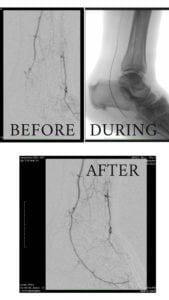Worried about leg pain with PAD? You're not alone! Peripheral Arterial Disease causes symptoms that can mimic those of other health conditions. And that means you often wait to get a diagnosis. Take a classic symptom like tired, heavy legs, for example. At some point, everyone’s legs get tired. If you’ve walked a lot during the day, had a hard work out, or just been stuck on your feet, you may get muscle cramps or leg fatigue. And that would be perfectly normal.
Sometimes, however, that discomfort in your legs could be a symptom of PAD, a condition in which plaque narrows your arteries, limiting blood flow to your lower extremities. So how can you tell the difference? In this post, we review the warning signs in your legs that could indicate the onset of arterial disease.
5 Types of Leg Pain PAD Causes (and 1 Reason Why)

PAD-affected arteries before, during and after minimally invasive treatments
Now, anyone experiencing these types of leg pain PAD can cause should seek a consultation. However, that is especially true if your lifestyle puts you at risk for this condition. And that means if you smoke, have diabetes, have high blood pressure or have high cholesterol, your disease risk is increased. (Remember, cholesterol is a fatty substance your liver produces. You need some cholesterol for your body to function. But choose the 'bad' kind, or allow cholesterol levels to rise too high, and it can form blood-flow blocking 'plaque' in your arteries.) So, if you have these risk factors and experience regular leg pain, be sure to get checked for PAD. At our vascular clinics in Texas, we can help you get an accurate diagnosis and begin exploring treatment options.
In addition to leg pain, PAD can cause changes in your skin color or texture; poor toenail growth; and even erectile dysfunction in men.
We can diagnose PAD in our office with a bedside test called an Ankle-Brachial Index (ABI), which uses ultrasound and blood pressure cuffs to evaluate the circulation in your arms and legs. If this test is abnormal, we may order further imaging tests such as Magnetic Resonance Angiography (MRA) or Computed Tomography (CT) to determine the extent of your problem and help us plan your treatment.
PAD is a serious medical condition, but help is readily available, often without surgery. Using minimally invasive procedures, our Houston and Dallas area vascular specialists can help open up your arteries and restore blood flow to your lower extremities. But before we can help, you need an accurate diagnosis, so watch for warning signs and request an immediate consultation if you notice any concerning symptoms.

Scheduling
Please contact our dedicated specialists to schedule a consultation today.
2025 Texas Endovascular. All rights reserved. Website Design by Healthcare Success